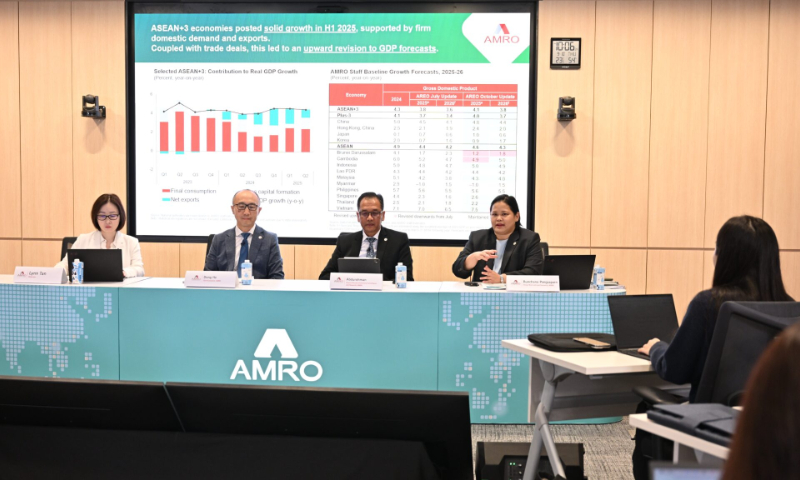ASEAN+3 economic growth outlook remains resilient, despite heightened external uncertainties: report
 The ASEAN+3 Macroeconomic Research Office (AMRO) released its ASEAN+3 Financial Stability Report (AFSR) 2025 and the ASEAN+3 Regional Economic Outlook (AREO) October Update in Singapore, on October 9, 2025. Photo: AMRO
The ASEAN+3 Macroeconomic Research Office (AMRO) released its ASEAN+3 Financial Stability Report (AFSR) 2025 and the ASEAN+3 Regional Economic Outlook (AREO) October Update in Singapore, on October 9, 2025. Photo: AMRO
The economic growth of the region combining China, Japan, South Korea and ASEAN, or ASEAN+3, is forecasted to reach 4.1 percent in 2025 and 3.8 percent in 2026, reflecting the region’s resilience in the face of heightened uncertainties caused by the US trade policy and geopolitical tensions, according to an outlook report released the ASEAN+3 Macroeconomic Research Office (AMRO) on Thursday.
The October outlook was an upward revision from July’s forecast, supported by robust first-half performance and stronger-than-expected export momentum. Market pressures have gradually eased since peaking in April following the US announcement of the “Liberation Day” tariffs, said AMRO.
“While intra-regional trade and domestic demand have become increasingly important growth drivers across ASEAN+3, the region remains deeply connected to the global financial system and is therefore not insulated from global shocks,” said AMRO Chief Economist Dong He, according to a release by AMRO. “Overall, the region’s financial system remains resilient, although pockets of vulnerabilities persist.”
He said that with coordinated actions and deeper financial cooperation and integration, ASEAN+3 can turn today’s challenges into tomorrow’s opportunities, and emerge stronger, more connected, and more resilient.
Export-oriented corporate sectors – particularly smaller firms with high exposure to US market – may face pressures on profit margins amid shifting trade dynamics. Inflation pressures in the US could persist amid higher import tariffs, complicating the US Fed’s monetary policy stance and potentially triggering spill-overs to other parts of the world. Additionally, growing uncertainty around the US dollar’s safe-haven status could further fragment the global financial landscape, read AMRO’s release.
Despite the challenges, ASEAN+3 economies remain well-positioned to navigate global headwinds. Well-calibrated policy mixes and strong fundamentals – including robust banking systems, deepening financial markets, ample foreign reserves, and available policy space – have provided buffers. With inflation largely subdued and expectations well-anchored in most economies, central banks can maintain accommodative monetary policy to support growth, said AMRO.
At the same time, macro-prudential tools, along with foreign exchange and capital flow management measures, offer additional safeguards to maintain financial stability and mitigate external spill-overs.
However, AMRO underscores that support should be carefully targeted to vulnerable sectors and deployed prudently to preserve policy space amid elevated external uncertainty.
Beyond near-term risks, the region is undergoing deeper structural transitions. Most notably, the rapid digitalization of financial services presents opportunities for greater financial inclusion and efficiency, the report noted.
“Digitalization of the banking sector is reshaping the market structure, offering new pathways for inclusion and efficiency,” said Runchana Pongsaparn, AMRO Group Head for Financial Surveillance, according to AMRO’s release. “But it also alters the nature and distribution of financial stability risks. Policymakers must adopt a multi-pronged strategy that promotes innovation while managing risks.”
The 22nd China-ASEAN Expo (CAEXPO) held in September, with artificial intelligence (AI) as its central theme, showcased the latest achievements in the digital economy and AI cooperation. Held as the Version 3.0 China-ASEAN Free Trade Area (CAFTA) negotiations concluded, the expo highlighted CAFTA 3.0’s nine key areas, prioritizing digital economy.
In May, negotiations on the 3.0 CAFTA were fully concluded, marking the first time a comprehensive cooperation framework was established that linked both “hard connectivity” in digital infrastructure and “soft connectivity” in rules and standards, achieving an upgrade in regulations, said China’s Ministry of Commerce.
Source: Global Times

